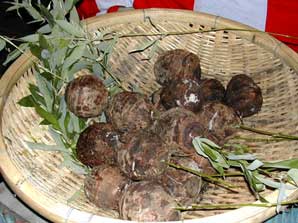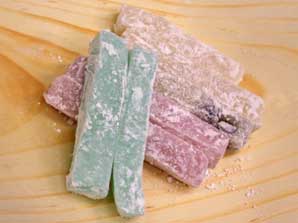Web Japan > Trends in Japan > Food & Travel > Raking in Good Fortune
Raking in Good Fortune
Wishing for a Good Year at the "Rooster Market"
Japan is home to numerous annual events with an ancient pedigree. One of these is the Tori no Ichi, or "rooster market," held on the days designated "days of the rooster" under the traditional calendar in November each year. Dating back to the Edo period (1603-1868), the markets are held at temples and shrines where people go to wish for happiness, good fortune, and success in business. The markets are famous for the brightly decorated bamboo rakes called kumade that are sold there.
Keeping Traditions AliveNo one knows for certain when the first Tori no Ichi took place, but the event's origins are said to lie in a harvest festival that used to be held by farmers each autumn. At the Otori Shrine on the outskirts of Edo (in what is today part of Tokyo's Adachi City), local farmers would give thanks for the harvest by offering a chicken to the shrine's deity on days of the rooster occurring during November. The rooster is one of the 12 animals of the Chinese zodiac used to designate hours, days, and years on the traditional calendar. The day of the rooster comes around once every 12 days, so that there are two or three days of the rooster each November.
In time, a market sprang up around the shrine, and what started as a local farmers' market selling recently harvested crops and farming implements came to attract ever greater numbers of worshipers coming to pay their respects at the shrine.
The most famous Tori no Ichi is the market held at the Chokokuji Temple and Otori Shrine in Asakusa, in the old shitamachi (traditional neighborhood for merchants and artisans) part of Tokyo. The festival dates back more than 230 years and is still cherished today as one of the most important events held to mark the approach of the year end. Asakusa was one of Edo's busiest districts, and its Tori no Ichi began in around 1771. The market has been held every year since and today attracts around 150 stalls selling the famous good-luck rakes called kumade. These are believed to "rake up" and "sweep in" good luck and prosperity for the coming year, and when the designated day rolls around, the shrine and the temple fill up with people eager to gain a share of the good fortune. Between700,000 and 800,000 people visit the festival each year.
The tradition is that people bring back the old kumade that have adorned their homes for the past 12 months and buy new ones for the coming year. The festival remains an important and much anticipated part of preparations for the New Year.
Good Luck Charms On Tori no Ichi days, kumade stalls fill the narrow alleys around the shrine and the temple, creating a lively, colorful scene unique to these traditional annual events. Originally used for sweeping up fallen leaves, the kumade was transformed by the Edo townspeople's love of style into an auspicious and brightly decorated charm believed to bring good fortune. The bamboo kumade are covered in colorful amulets and tokens of prosperity, such as shining replicas of old gold coins; ears and bales of rice to mark the harvest; and pine, bamboo, and plum, traditional symbols of good fortune.The grounds of the shrine are filled with the sounds of the kumade sellers competing for custom. Small rakes made for the tourist trade sell for around ¥1,000 (about $11 at ¥90 to the dollar), but the best-selling items are more elaborate rakes costing between ¥10,000 and ¥50,000. People haggle with the sellers before fixing on a price. Once a price has been agreed, the sellers clap their hands together and sing out a prayer for the buyer's good health and prosperity in the coming year. It is an experience unique to the Tori no Ichi.
Stalls selling food and souvenirs crowd the area around the shrine on festival days. One specialty that has been famous since the Edo Period is to no imo (big taros), which is believed to bring success. Another famous treat is kirizansho. Made from a mixture of sugar, powdered Japanese pepper, and rice flour, this chewy candy has a perfect balance of sweetness and spice.
Small open-air taverns line the streets outside the shrine precincts, selling sake and other drinks along with tasty snacks like skewered chicken and grilled fish. The Tori no Ichi is a place where people come not just to wish for good fortune but to eat, drink, and have a good time. Visitors continue to throng the venue until deep into the night. (December 2009)
- The Kanto Lantern Parade (November 2009)




